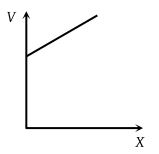Two identical point charges are placed at a separation of d. P is a point on the line joining the charges, at a distance x from any one charge. The field at P is E, E is plotted against x for values of x from close to zero to slightly less than d. Which of the following represents the resulting curve?
(1) 
(2) 
(3) 
(4) 




When subjected to a transverse electric field, cathode rays move:
(1) Down the potential gradient
(2) Up the potential gradient
(3) Along a hyperbolic path
(4) Along a circular path
The kinetic energy of an electron which is accelerated through a potential of 100 volts is
(a) (b) 418.6 calories
(c) (d) W- sec
An particle is accelerated through a p.d of volt then K.E. of particle will be
(1) 8 MeV
(2) 4 MeV
(3) 2 MeV
(4) 1 MeV
A condenser of 2μF capacitance is charged steadily from 0 to 5 Coulomb. Which of the following graphs correctly represents the variation of potential difference across its plates with respect to the charge on the condenser?
(1)
(2)
(3)
(4)
Equipotential surfaces are shown in figure. Then the electric field strength will be
(1) 100 Vm–1 along X-axis
(2) 100 Vm–1 along Y-axis
(3) 200 Vm–1 at an angle 120o with X-axis
(4) 50 Vm–1 at an angle 120o with X-axis
Figure (a) shows two capacitors connected in series and joined to a battery. The graph in figure (b) shows the variation in potential difference as one moves from left to right on the branch containing the capacitors, if
(1) C1 > C2
(2) C1 = C2
(3) C1 < C2
(4) The information is not sufficient to decide the relation between C1 and
Between the plates of a parallel plate capacitor a dielectric plate is introduced just to fill the space between the plates. The capacitor is charged and later disconnected from the battery. The dielectric plate is slowly drawn out of the capacitor parallel to the plates. The plot of the potential difference across the plates and the length of the dielectric plate drawn out is
(1)
(2)
(3)
(4)
What physical quantities may X and Y represent ? (Y represents the first mentioned quantity)
(1) Pressure v/s temperature of a given gas (constant volume)
(2) Kinetic energy v/s velocity of a particle
(3) Capacitance v/s charge to give a constant potential
(4) Potential v/s capacitance to give a constant charge
In a hollow spherical shell potential (V) changes with respect to distance (r) from centre
(1)
(2)
(3)
(4)





















